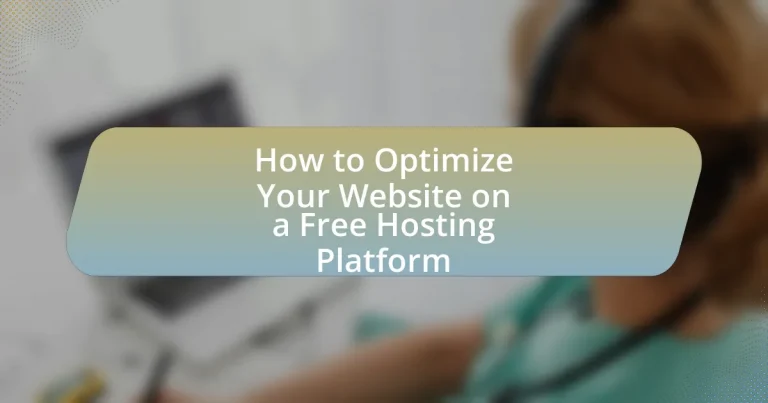Optimizing a website on a free hosting platform involves enhancing its performance, speed, and user experience while navigating the inherent limitations of such services. Key strategies include minimizing file sizes, utilizing efficient coding practices, and leveraging caching to improve load times, as even minor delays can significantly impact conversion rates. The article explores the negative effects of free hosting on website performance, the constraints imposed on optimization, and the importance of website optimization for user engagement and search engine rankings. Additionally, it outlines practical techniques for improving website speed, creating SEO-friendly content, and maintaining performance over time, while addressing common challenges and technical issues faced during the optimization process.

What does it mean to optimize your website on a free hosting platform?
Optimizing your website on a free hosting platform means enhancing its performance, speed, and user experience while adhering to the limitations of the free service. This involves techniques such as minimizing file sizes, using efficient coding practices, and leveraging caching to improve load times. For instance, research indicates that a one-second delay in page load time can lead to a 7% reduction in conversions, highlighting the importance of speed optimization. Additionally, optimizing images and utilizing content delivery networks (CDNs) can further enhance accessibility and performance, even within the constraints of free hosting services.
How does free hosting impact website performance?
Free hosting negatively impacts website performance by often providing limited resources, slower loading times, and reduced reliability. Websites hosted on free platforms typically share server resources with numerous other sites, leading to congestion and slower response times. According to a study by Google, a one-second delay in loading time can lead to a 20% decrease in conversions, highlighting the importance of speed for user engagement. Additionally, free hosting services may impose bandwidth restrictions, resulting in downtime during peak traffic periods, which further diminishes user experience and site accessibility.
What limitations do free hosting platforms impose on optimization?
Free hosting platforms impose several limitations on optimization, primarily including restricted access to server resources, limited bandwidth, and lack of control over server configurations. These constraints hinder the ability to implement advanced optimization techniques such as caching, content delivery networks (CDNs), and custom server settings. For instance, many free hosting services do not allow the installation of plugins or scripts that could enhance website performance, which directly impacts loading speeds and overall user experience. Additionally, free hosting often includes advertisements and branding that can detract from the site’s professionalism and user engagement, further limiting optimization potential.
How can these limitations affect user experience?
Limitations of a free hosting platform can significantly degrade user experience by causing slow loading times and frequent downtime. Slow loading times can lead to higher bounce rates, as studies show that 40% of users abandon a website that takes more than three seconds to load. Frequent downtime disrupts access to content, frustrating users and potentially damaging brand reputation. Additionally, limited storage and bandwidth can restrict website functionality, leading to a lack of essential features that users expect, such as multimedia content or interactive elements. These factors collectively diminish user satisfaction and engagement, ultimately affecting the website’s effectiveness in achieving its goals.
Why is website optimization important for free hosting users?
Website optimization is crucial for free hosting users because it enhances performance and user experience despite limited resources. Free hosting services often come with restrictions such as slower loading speeds and bandwidth limitations, making optimization essential to ensure that websites load quickly and efficiently. According to Google, a one-second delay in mobile load times can lead to a 20% decrease in conversions, highlighting the importance of speed in retaining visitors. Additionally, optimized websites are more likely to rank higher in search engine results, which is vital for attracting organic traffic, especially when users are competing with numerous other free hosting sites.
What are the key benefits of optimizing a website on a free hosting platform?
Optimizing a website on a free hosting platform offers several key benefits, including cost-effectiveness, accessibility, and improved performance. Cost-effectiveness is evident as free hosting eliminates expenses associated with paid services, allowing users to allocate resources to other areas of their website development. Accessibility is enhanced since free hosting platforms often provide user-friendly interfaces and tools that simplify the optimization process for individuals with limited technical skills. Improved performance can be achieved through optimization techniques such as image compression and caching, which can enhance loading speeds even on free hosting services. These benefits collectively enable users to create functional and efficient websites without incurring significant costs.
How does optimization influence search engine rankings?
Optimization directly influences search engine rankings by enhancing a website’s relevance and usability, which search engines prioritize in their algorithms. Effective optimization techniques, such as keyword integration, meta tag utilization, and mobile responsiveness, improve a site’s visibility in search results. For instance, according to a study by Moz, on-page optimization factors account for approximately 25% of ranking factors, highlighting the importance of optimizing content and structure. Additionally, Google’s algorithm updates consistently favor sites that provide a better user experience, further emphasizing the need for optimization to achieve higher rankings.

What strategies can be employed to optimize a website on a free hosting platform?
To optimize a website on a free hosting platform, focus on improving loading speed, enhancing user experience, and utilizing SEO best practices. Improving loading speed can be achieved by compressing images and minimizing code, as studies show that a one-second delay in page load time can lead to a 7% reduction in conversions. Enhancing user experience involves ensuring mobile responsiveness and intuitive navigation, which are critical since over 50% of web traffic comes from mobile devices. Implementing SEO best practices, such as using relevant keywords and optimizing meta tags, can increase visibility; research indicates that 75% of users never scroll past the first page of search results. By applying these strategies, a website on a free hosting platform can achieve better performance and visibility.
How can you improve website speed on a free hosting platform?
To improve website speed on a free hosting platform, optimize images by compressing them to reduce file size without sacrificing quality. This can significantly decrease loading times, as images often account for a large portion of a webpage’s total size. For instance, using tools like TinyPNG or ImageOptim can reduce image sizes by up to 70% while maintaining visual fidelity. Additionally, minimizing HTTP requests by combining CSS and JavaScript files can further enhance speed, as fewer requests lead to faster loading times. Implementing browser caching allows returning visitors to load pages more quickly, as static resources are stored locally. These strategies collectively contribute to a noticeable improvement in website performance on free hosting platforms.
What tools can help analyze website speed?
Tools that can help analyze website speed include Google PageSpeed Insights, GTmetrix, and Pingdom. Google PageSpeed Insights evaluates the performance of a webpage on both mobile and desktop devices, providing suggestions for improvement based on real-world data. GTmetrix combines Google Lighthouse and WebPageTest to offer detailed insights into page load times and performance metrics. Pingdom provides a user-friendly interface to test website speed from multiple locations, offering performance grades and recommendations for optimization. These tools are widely recognized in the industry for their accuracy and effectiveness in identifying speed-related issues on websites.
What techniques can be used to reduce loading times?
To reduce loading times, techniques such as image optimization, browser caching, and minimizing HTTP requests can be employed. Image optimization involves compressing images without sacrificing quality, which can significantly decrease file sizes and loading times. Browser caching allows frequently accessed resources to be stored locally on a user’s device, reducing the need for repeated downloads. Minimizing HTTP requests by combining files, such as CSS and JavaScript, reduces the number of requests made to the server, thus speeding up the loading process. These methods are supported by studies indicating that optimized images can reduce load times by up to 80%, and effective caching strategies can improve performance by 50% or more.
What role does content play in website optimization?
Content plays a crucial role in website optimization by enhancing search engine visibility and user engagement. High-quality, relevant content improves a website’s ranking on search engines, as algorithms prioritize sites that provide valuable information to users. For instance, according to a study by HubSpot, websites that regularly publish blog content receive 97% more links to their site, which is a significant factor in SEO performance. Additionally, well-structured content that incorporates keywords naturally can lead to better indexing by search engines, further boosting visibility. Therefore, effective content strategy is essential for optimizing a website, especially on free hosting platforms where competition for attention is high.
How can you create SEO-friendly content on a free hosting platform?
To create SEO-friendly content on a free hosting platform, focus on keyword optimization, quality content, and proper formatting. Keyword optimization involves researching relevant keywords using tools like Google Keyword Planner and incorporating them naturally into your content, titles, and meta descriptions. Quality content should be informative, engaging, and original, as search engines prioritize valuable information for users. Proper formatting includes using headings, bullet points, and short paragraphs to enhance readability, which can improve user experience and reduce bounce rates. According to a study by Backlinko, content that is well-structured and easy to read can lead to higher rankings in search engine results.
What are the best practices for using images and multimedia?
The best practices for using images and multimedia include optimizing file sizes, using appropriate formats, and ensuring accessibility. Optimizing file sizes reduces loading times, which is crucial for user experience and SEO; for instance, images should ideally be under 100 KB without sacrificing quality. Using appropriate formats, such as JPEG for photographs and PNG for graphics with transparency, enhances visual quality and performance. Ensuring accessibility involves adding alt text to images, which improves usability for visually impaired users and contributes to better search engine indexing. These practices collectively enhance website performance and user engagement, particularly on free hosting platforms where resources may be limited.

What are common challenges faced when optimizing a website on a free hosting platform?
Common challenges faced when optimizing a website on a free hosting platform include limited bandwidth, lack of customization options, and slower loading speeds. Limited bandwidth restricts the amount of data that can be transferred, which can lead to site downtime during high traffic periods. Lack of customization options often means that users cannot implement essential SEO practices or design elements, hindering their ability to improve search engine rankings. Additionally, slower loading speeds, which are common on free hosting services, negatively impact user experience and can lead to higher bounce rates, ultimately affecting site performance and visibility.
What technical issues might arise during optimization?
Technical issues that might arise during optimization include limited server resources, which can lead to slow loading times and reduced performance. Free hosting platforms often impose restrictions on bandwidth, storage, and processing power, making it challenging to implement resource-intensive optimization techniques. Additionally, compatibility issues may occur with certain plugins or scripts that are not supported by the free hosting environment, potentially causing functionality problems. Security vulnerabilities can also arise, as free hosting services may lack robust security measures, exposing the website to risks during optimization processes. These factors collectively hinder effective optimization efforts, as evidenced by user experiences reported in various online forums and reviews of free hosting services.
How can you troubleshoot common technical problems?
To troubleshoot common technical problems, first identify the specific issue by gathering error messages or symptoms. For example, if a website fails to load, check the internet connection, browser settings, and server status. Next, systematically isolate the problem by testing different components, such as disabling plugins or clearing the cache. According to a study by the Nielsen Norman Group, 70% of users abandon a website due to slow loading times, highlighting the importance of addressing performance issues promptly. By following these steps, users can effectively diagnose and resolve technical problems.
What are the limitations of free hosting that affect optimization?
Free hosting has several limitations that significantly affect website optimization. These limitations include restricted bandwidth, which can lead to slow loading times, and limited storage space, which may prevent the hosting of high-quality images or extensive content. Additionally, free hosting often imposes advertising on websites, detracting from user experience and potentially harming SEO rankings. Furthermore, the lack of customer support can hinder troubleshooting and optimization efforts. Security features are typically minimal, increasing vulnerability to attacks, which can negatively impact site performance and reliability. These factors collectively restrict the ability to effectively optimize a website hosted on a free platform.
How can you measure the success of your optimization efforts?
You can measure the success of your optimization efforts by analyzing key performance indicators (KPIs) such as website traffic, conversion rates, and user engagement metrics. For instance, an increase in organic traffic indicates improved search engine visibility, while higher conversion rates suggest that optimization strategies effectively guide users toward desired actions. Additionally, tools like Google Analytics provide detailed insights into user behavior, allowing for the assessment of bounce rates and session durations, which further reflect the effectiveness of optimization efforts.
What metrics should you track to evaluate website performance?
To evaluate website performance, track metrics such as page load time, bounce rate, conversion rate, and user engagement. Page load time is critical as studies show that a one-second delay can reduce conversions by 7%. Bounce rate indicates the percentage of visitors who leave after viewing only one page, with a high rate suggesting issues with content or user experience. Conversion rate measures the percentage of visitors completing desired actions, reflecting the effectiveness of the website in achieving its goals. User engagement metrics, including average session duration and pages per session, provide insights into how effectively the website retains visitor interest. These metrics collectively offer a comprehensive view of website performance and areas for improvement.
How can analytics tools assist in measuring optimization success?
Analytics tools assist in measuring optimization success by providing data-driven insights into user behavior, engagement metrics, and conversion rates. These tools track key performance indicators (KPIs) such as page views, bounce rates, and average session duration, allowing website owners to identify which optimization strategies are effective. For instance, Google Analytics reports that businesses using data analytics can improve their marketing ROI by up to 15-20% by making informed decisions based on user data. This concrete evidence demonstrates that analytics tools are essential for evaluating the impact of optimization efforts on a website’s performance.
What are some best practices for optimizing your website on a free hosting platform?
To optimize your website on a free hosting platform, focus on minimizing resource usage and enhancing performance. First, choose a lightweight website design that reduces loading times; for instance, using minimalistic themes can significantly improve speed. Second, compress images and files to decrease their size without sacrificing quality, which can lead to faster page loads. Third, utilize caching techniques to store frequently accessed data, reducing server load and improving user experience. Fourth, implement SEO best practices, such as optimizing meta tags and using relevant keywords, to enhance visibility in search engines. Lastly, regularly monitor website performance using tools like Google PageSpeed Insights to identify areas for improvement. These practices are essential as studies show that a one-second delay in page load time can lead to a 7% reduction in conversions.
How can regular updates and maintenance improve optimization?
Regular updates and maintenance enhance optimization by ensuring that website software, plugins, and security measures are current and functioning effectively. Keeping software updated reduces vulnerabilities, which can lead to faster loading times and improved user experience. For instance, a study by Google found that a one-second delay in page load time can lead to a 20% decrease in conversions. Additionally, regular maintenance helps identify and fix broken links or outdated content, which can negatively impact search engine rankings. By addressing these issues promptly, websites can maintain higher performance levels and better visibility in search results.
What tips can help maintain website performance over time?
To maintain website performance over time, regularly monitor site speed and optimize images. Monitoring tools like Google PageSpeed Insights provide insights into loading times and performance metrics, allowing for timely adjustments. Optimizing images by compressing them reduces file sizes without sacrificing quality, which can significantly enhance loading speeds. Additionally, implementing caching strategies, such as browser caching and server-side caching, can improve performance by storing frequently accessed data. Regularly updating software, including plugins and themes, ensures security and compatibility, which also contributes to optimal performance. According to a study by Akamai, a 100-millisecond delay in website load time can decrease conversion rates by 7%.





